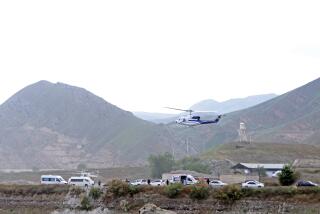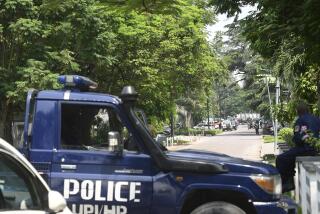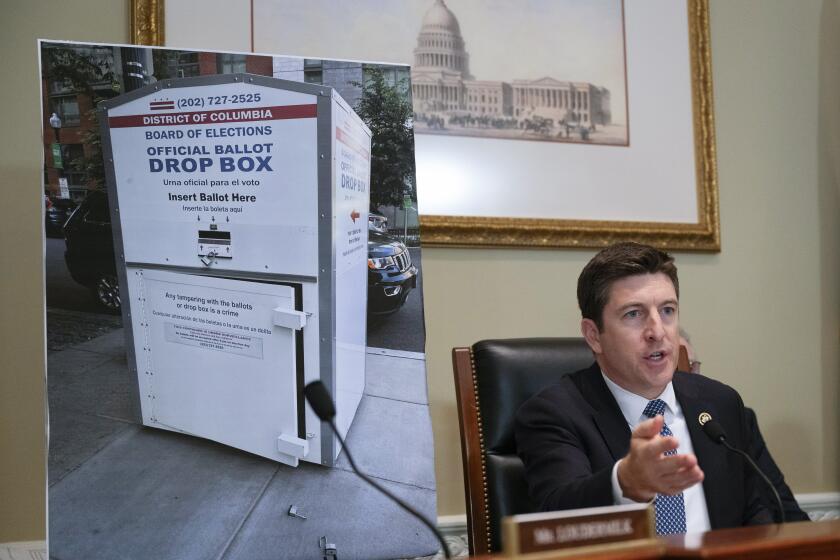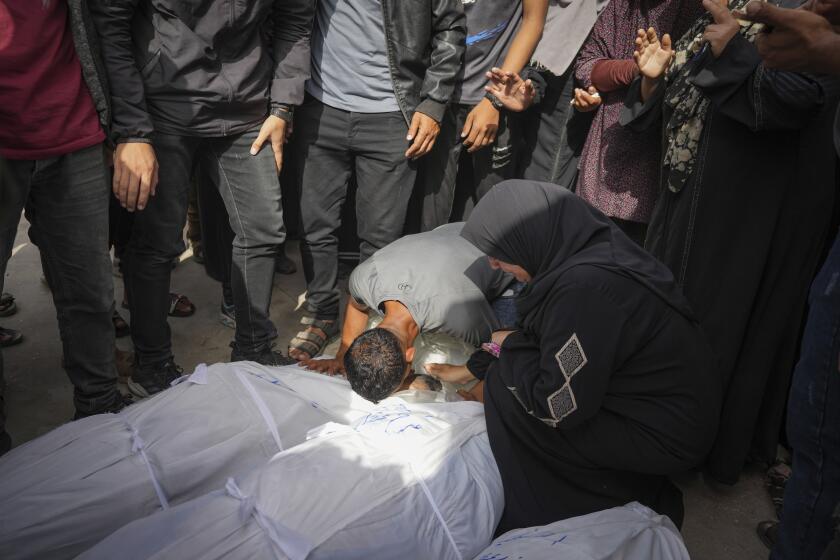Pentagon Calls Raid a Success, Cites Surprise : Says Nighttime Attack Caught Libya off Guard; U.S. Planes Press Search for 2 Missing Airmen
Less than a day after the raid on five targets linked to terrorist activities in Libya, U.S. officials Tuesday portrayed “Operation Eldorado Canyon” as a successful mission in which long-range bombers and short-range carrier-based aircraft performed a closely coordinated, night-time bombing raid that apparently achieved total surprise.
As U.S. military forces searched hostile waters off Tripoli for two airmen lost when their F-111 went down, Reagan Administration officials began reviewing the results of the lightning-fast mission that involved more than 130 airplanes and hit five targets in Tripoli and Benghazi in the space of just 12 minutes. Despite what he described as heavy Libyan missile fire, Pentagon spokesman Robert B. Sims
said--without disclosing his source--that three to five Soviet-built Ilyushin 76 four-engine jet transports were damaged on the military side of the Tripoli airfield, and that five to 12 Soviet-built MIG 23 fighters, the most sophisticated in the Libyan arsenal, had been damaged at the Benina air base, where a spare parts hanger was destroyed.
Sims said that another target, the Aziziya Barracks, which Defense Secretary Caspar W. Weinberger has said was a terrorism command and control headquarters, suffered structural damage in the raid.
Meanwhile, Navy pilots who took part in the operation speculated that Libyan surface-to-air missiles that soared straight up and fell back to the ground without striking aerial targets may have been responsible for some of the damage in Libya.
Sims said that partly cloudy skies over Libya prevented a thorough assessment of the damage to targets and surrounding areas. Such reports generally are assembled from photographs made by high altitude aircraft and satellites. What was described as intelligence from “friendly” agents on the ground can also contribute to the assessment.
He said that the French Embassy, apparently damaged during the operation--although U.S. officials refused to acknowledge that the damage was caused by U.S. weapons--was situated between two targets.
When asked about damage to the embassy, one of the pilots interviewed aboard the aircraft carrier America said: “It appeared to me that if there was collateral damage in Tripoli, it was done by Libyans themselves firing missiles straight up into the air which came down to the city.”
Another pilot described a missile attack he encountered: “It kind of looks surreal because how could it be a star going that fast, and then you realize that it might be going for you, and that snaps you right back to reality.”
While the U.S. fleet operated in the central Mediterranean throughout the day after the raid, American airplanes and ships conducted searches for the missing F-111 crew in the sea north of Tripoli, encountering no opposition from Libyan forces.
Officials said they had no indications that the two fliers ejected from the F-111--the only one of the 18 fighter-bombers that did not land safely. One aircraft landed in Spain, after an engine overheated, and the other 16 returned to their bases in Britain.
The two crew members of the missing fighter-bomber were identified by the Pentagon as Capt. Fernando L. Ribas Dominicci, 33, of Puerto Rico, the pilot, and Capt. Paul F. Lorence, 31, of San Francisco, the weapons officer.
Sims said that they did not report at a rendezvous point after the raid.
A Pentagon official, speaking on the condition that he not be identified by name, said a U.S. pilot reported seeing a “fireball” before the airplanes reached their targets in Tripoli, although other sources said the apparent explosion was seen after the raid. These sources also cautioned that what the pilot claimed to have seen may have been unrelated to the missing airplane.
However, said another source, “I don’t think anybody has much hope” of finding the fliers.
Ejection capsules on F-111s carry strobe lights and beeping devices set to generate signals as soon as they separate from the airplane fuselage. Officials said there were no indications of such signals.
According to Pentagon officials, the raid involved 18 U.S. Air Force F-111s based at two British air bases--Upper Heyford and Lakenheath--and 15 A-6 Corsairs, which are light bombers that were launched by the America and another carrier, the Coral Sea. The carriers were operating just north of the Libyan “Flight Information Region,” a strip of the Mediterranean Sea that extends north of Libyan leader Moammar Kadafi’s “Line of Death” delineating the mouth of the Gulf of Sidra.
Two FA-18 squadrons from El Toro Marine Corps Air Station are aboard the Coral Sea, but it was not known what role they had played in the operation, a Marine Corps spokesman in Washington said Tuesday. The spokesman declined to give the location of two A-6 squadrons that have been deployed from El Toro other than to say that “they didn’t have anything to do with Libya.”
Sims said that the carriers were operating in the same region later Tuesday, and “they’ll stay there as long as necessary.”
The F-111s struck in three waves, with two approaching targets in Tripoli from the north, over the Mediterranean and a third crossing Libyan territory east of the capital city, flying south over the desert, making a U-turn to the west, and striking the city from the south, one Administration source said.
At the same moments, the A-6s struck targets in Benghazi, several hundred miles to the east on the coast of the Gulf of Sidra, according to Sims.
The Pentagon spokesman said that the entire raid, which began at 2 a.m. Tuesday Libyan time (4 p.m. PST Monday), lasted 11 or 12 minutes.
The F-111s dropped 750- and 2,000-pound bombs--so-called “smart” munitions that use lasers and other sophisticated systems for guidance. One source said the bombs carried “drag chutes” to slow their descent while the low-level bomber hurries out of their explosive range. The A-6s, the source said, carried gravity bombs.
Joining the aerial armada were about 100 other airplanes, including tankers dispatched from Mildenhall air base in England to refuel the F-111s, A-7 attack aircraft and F/A-18 fighters launched by the carriers, and a variety of other carrier-based airplanes, including E-2C battle command ships, EA-6B Prowlers, which were said to have effectively sent out electronic signals to interfere with Libyan surface-to-air missile guidance and other electronic systems, and F-14s, given an interceptor role.
The A-7s and F/A-18s, operating at long distances well north of the Libyan coast, fired “dozens” of high-speed anti-radiation missiles at Libyan air defenses, Sims said.
Nevertheless, the Libyans managed to launch Soviet supplied surface-to-air missiles, and the American pilots met what Sims described as “heavy....fire” in the Benghazi area, as well as missile and anti-aircraft fire around Tripoli.
“We think the defenders were confused as well as surprised,” he said. “The success of the mission was due to surprise, electronic jamming, missile suppression, low-level attack tactics, and the cover of night.”
Sims said that Pentagon planners, exercising a plan developed several months ago involving the F-111s, said the planes based in Britain were called upon, despite the 6,400-mile, 14-hour round-trip flight, because the two carriers offered enough airpower to strike only two targets simultaneously.
The spokesman took issue with the caption on a Libyan photograph purporting to show the wreckage of an American aircraft in Libya. He said the item in the picture was the third stage of a SAM-3 missile manufactured by the Soviet Union.
More to Read
Start your day right
Sign up for Essential California for news, features and recommendations from the L.A. Times and beyond in your inbox six days a week.
You may occasionally receive promotional content from the Los Angeles Times.






